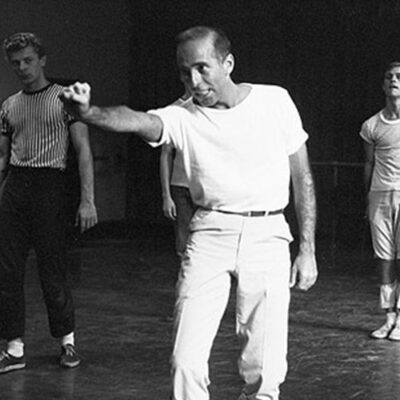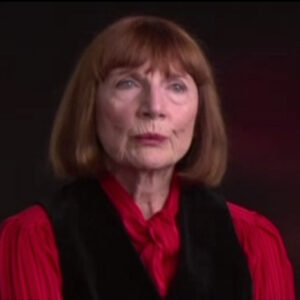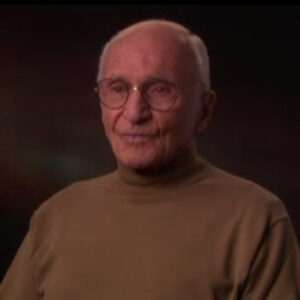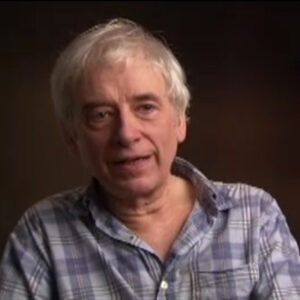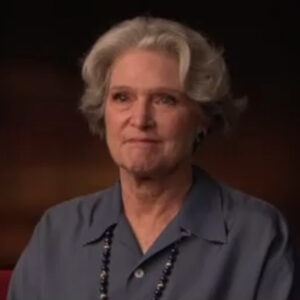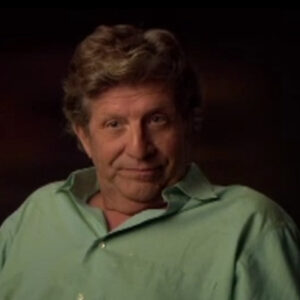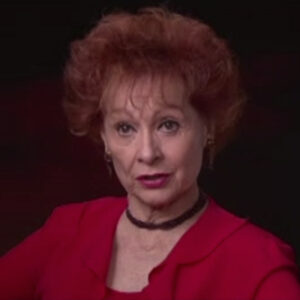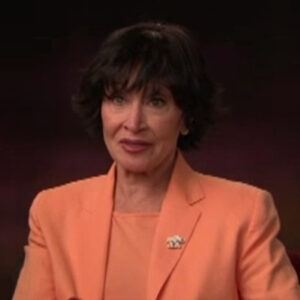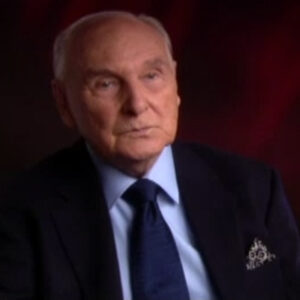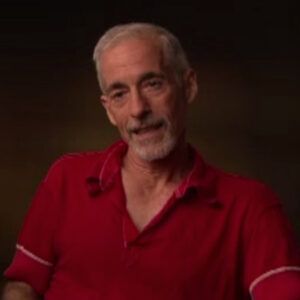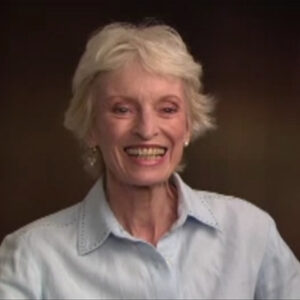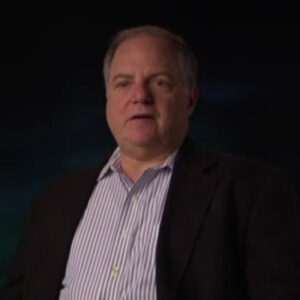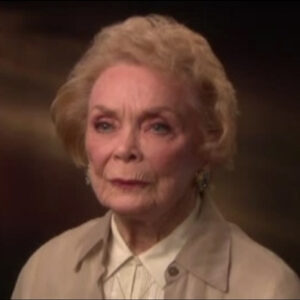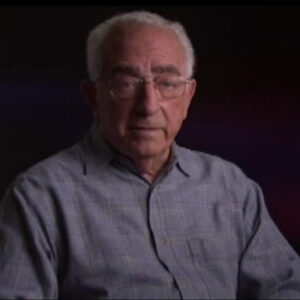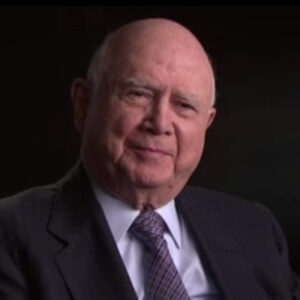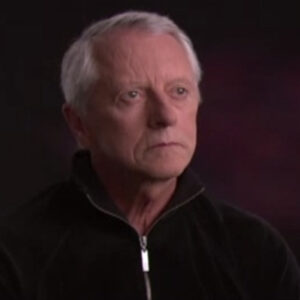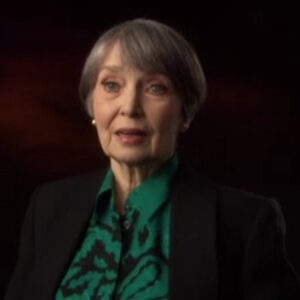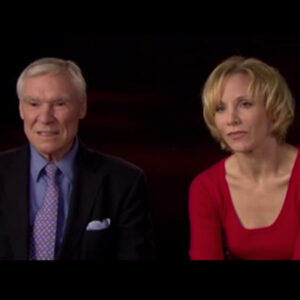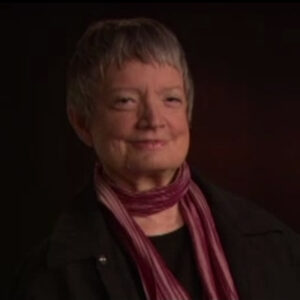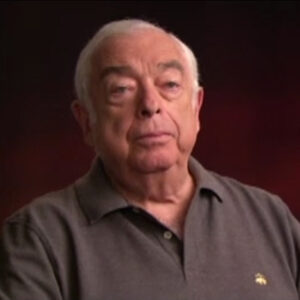Speaker Yes, I was I was in class at F.S.B, and Jerry was then doing the West Side Story and he came to take Mr. Abukar first class and he came in with the jets and the sharks. They all had sideburns and they were kind of incorrigible in the class because they they kind of be playing around during the class. And we were also serious little ballet dancers and trying to work hard. And but he would come quite often with with the group. You know, I think there was Tommy Albert and Gene Norman and a few of the others. And that was really my first face to face seeing Jerome Robbins. And I guess after that, what was your impression? Well, I was terrified because he was Jerome Robbins, you know, and I had seen his ballet ballets done with the New York City Ballet. Loved loved his the afternoon of a fall in the cage fanfare.
Speaker All all of the ballets he did were amazing. And I think later on I when I joined the company, I was 16 and I went into Pied Piper of Jerry Robbins in the court of L.A. and but he was away doing Broadway. So I never saw him. I never saw him rehearse ballets because he was quite busy with West Side Story. And I guess I was 1957 58. And he when I joined the company, I was cast in a lot of his roles. I don’t know. I’d like to ask him today if if he chose me for the roles or if Mr. Balanchine cast me. But at a very young age, I did like to ride away an afternoon of a born when I was 17, the cage.
Speaker And before we go to ask you to tell me what the School of American Ballet is.
Speaker Oh, say, oh, a school of American Ballet. Is that the official school? Just so. Oh, the School of American Ballet. And I just need. Oh, thank you.
Speaker Once you got into New York City Ballet and you started to dance Jewry’s ballets, I think you were a few that he came and coached you, right?
Speaker Yes, that’s right. He actually I believe the first time he coached me was when I did Afternoon of a Fawn. And I had done it with Francisco Munson, who kind of coached me because Jerry wasn’t around to coach. But Edward Villella and I went to Jerry’s brownstone and he had a studio on the top floor. And we went there and were coached by him. And how extraordinary it was and how dear he was, how patient and what an amazing experience for a young person to have, you know, had that experience. And I loved him right away. I loved him. And it was a very kind of very sensitivity that he had. He was very gentle. He was very definite with what he had wanted. I guess when I did it, I had seen the people ahead of time. I had never seen Tannic LeClaire Dance Witz and was sad that I had never seen it. But I kind of grew up with watching Alegra can’t do it before I did. It was Hayden did it and it was a wonderful thing to have Jerry and to work with Eddie in it.
Speaker It’s amazing what he wanted. What did he want?
Speaker Well, he really wanted to you to wear new shoes, brand new shoes. So you would feel there’s a part when you make your entrance and you brush, you look at your shoes because they’re new in it.
Speaker And there’s an excitement of when you step into the room and the focus on the mirror and just focusing and just the way he would show was really beautiful. It was very intense and very beautiful. The way he would he he would show me it was much more detailed then than what I was used to. And I really loved the caring that he put into it.
Speaker And when you say it was more detailed, tell me what you mean by that. I mean that he spent more time on details, for example, Mawji. Yes.
Speaker Yeah, he was. He, of course, working with Mr. Balanchine was always really quick, quick, and you learn something really fast. And then it would be yours and you would make something of it. And he was always. There and he would give he would you know, that he would correct you, but with Jerome Robbins on actually it was on the special things that he choreographed to you would have a lot more freedom in. But with something that was already choreographed, it was tanuki. LeClaire had done it before and other dancers have done it. He was very specific. And I’d say with Jerry, if you created the role and the ballet when it was finished and it would be done many times later, he always had the creation of the role foremost in his mind. And you would he would almost be afraid that it would change. And he wanted the same feeling from the beginning. It was choreographed continue on in the future generations of dancers.
Speaker And I think he felt that it was it was such a success that it was he didn’t want it to be less than what it was and that the opening the first performance of it and I was a young dancer. So it was about young people in a in a ballet studio looking at themselves in the mirror. And I just love the attention to the detail that he wanted. It made me very nervous because I wanted to please him and to do exactly what he wanted of me. And because I didn’t know him that well, then it was just the beginning of working with him. But it was a wonder. I went away and I felt it was a wonderful experience. I was just so happy to have the chance to work with him and kids.
Speaker Actually, I had gone to Mr. Balanchine, sent a LeGrande eye to a Broadway theater where he was I must have been his own company, Ballies, USA, to sort of learn it to to watch him and see how he was rehearsing it. And then I did it at a very young age when I was 18. And Frank Francisco Mansfield had coached me in it and I performed it without ever having worked with with Jerry and I. I remember when he came into the company, I did it at such a young age, but it was so different working with him and the details again and trying to do what he wanted. I had my idea of of the role and I had seen Melissa Hayden, who was extraordinary in the role before me and Alegra Candleshoe. So I had an idea what it was about. But to get this great coaching from Jerry, it was one of the most specific ballets that I’d ever worked on him and all the ballets I did. He was most specific about what he wanted to create. And I’d say from 18 till I was 46, he was coaching me when I was my last season in the company. I was I was being coached in the cage and I love the ballet. It was an extraordinary work. And I was kind of awestruck even to be working with Jerome Robbins, who had created that work. It was a powerhouse of a role. And I remember being really embarrassed when I first learned doing those movements, going from a ballet student. And and I guess I was in the company two years when Mr. Balanchine I saw the cast and the name name on the casting went up.
Speaker So we had to learn it really fast and just to to do what Jerry wanted. And it got as even it had changed over the years. And I remember the last time I did it, he wanted he wanted the novice to be very vulnerable.
Speaker And I think when I first started it, it was all like strong, strong, powerful. And at the end, he very much wanted her to be vulnerable, sort of like a cult you can hardly walk and to have the feeling of that vulnerability. And she grows and she grows and she gets stronger at the end and she’s powerful at the end. It takes over being the queen at the end. But he showed it so beautifully. It was. It was. And he cared so much about it. I, I absolutely loved working with him and I felt very special because he made me feel special and he was very supportive. And I really tried to get him in my body to try to find what exactly what he wanted. I just want really wanted to please him and.
Speaker Try to find what he wanted in it and just to see just to see him doing some of the movements for me was amazing to see and it still stays. I can see him doing it in front of my eyes still today. And it was amazing.
Speaker And, oh, I remember something really cute. So I’m at the end of my career, I’m in my late almost 46 and he coached me like he coached every everyone every season doing his rep. And he wanted the vulnerability. And after the performance, there was a review. Jennifer Dunning gave a review of it. And the next day he read the paper. And he when I met him in the hallway, he said, see, because she said in the review, Jennifer said the vulnerability. So he I felt so happy that I could show, like, you never know what you’re looking like when you dance. And we didn’t have videos in those days to see ourselves. But I was so happy that Jerry was so pleased that the review I think reviews were really important to him to get a you know, to get a good and it was a good review, but it showed the it showed exactly what he wanted. So I was really happy about them.
Speaker When he was happy I was happy to talk about how when he showed you, what was it that he showed you that was so well, he he was so sensitive and so into everything. He showed me everything he did. He was just so involved and he was so moving to watch him doing it, and I always felt I loved working, I love being in the studio, it was a very intimate there’s a great intimacy to be with Jerry and working on these things and just imagine how he would explain it or it was visceral and he would show me how he wanted.
Speaker He wanted the arm like the tail of a squirrel. Do you know that movement where you go this, you know, with the fingers going like that?
Speaker So just to see him do it, to try to get that in in in my body was and it was such a great role you could totally lose yourself in. And it was amazing. And I’d say he was really more like a director, though. He hated me to say you’re like a director. But it was it was coaching and working from the inside out and having the most natural way. To to move into things and the musicality, because it was Stravinsky and he was just very specific and every every movement had something behind it, you know, he could explain, you know, the focus of where you look and what you’re feeling and. It was extraordinary and you would need that for a role like that, and I was so, so thankful to have had that time with him.
Speaker Um, when you get back to the company in sixty nine. It was he came back at an opportune moment in the company’s history. Can you tell me what was going on then?
Speaker So in in the company’s history. Uh, well.
Speaker It was it was fair and balanced, you mean that that particular story or I don’t think I want to go there? Well, I don’t think I want to go there, because if it hadn’t happened yet, we were rehearsing. And it the story you’re thinking about hadn’t happened yet. We had started, I believe, as far as I know, it hadn’t happened.
Speaker We’ll come back to that Jerry coming back because he was now a big Broadway director. They were used to.
Speaker Well, I think it was a most exciting time. We were all really terrifically excited about it.
Speaker And I think Mr. Balanchine or maybe during the rehearsals, Mr. Balanchine told me that Jerry would be coming. And he said and I just was kind of alone with him and he said, you know, you know, do your work, why he’s here because he’s good. And I was just thrilled to see my name go up with Edward Villella. Eddie and I had our rehearsal with him and I heard he was going to do a positive ready.
Speaker And I and I was just thrilled. I was just thrilled about it. And we because I had known him before and and worked with him before, I, I also knew him before with the interplay. He came back because I did the part, the girl and Interplay, and he came back and rehearsed interplay before we went to Russia the first time.
Speaker And usually it was opening night. We do Interplay was the first on the program and we did a long tour of Germany, two months in Russian 1962. And I remember Jerry coming to the city center and rehearsed us in in that.
Speaker So I had so many I had little feelings of of Jerry being and meeting him and working with him. And I always loved to work with him. And so when he came and there were rumors about dances at a gathering, we didn’t even know the name of it at that time.
Speaker But it was going to be just Partita with Eddie and I. And we started and I was excited and it went really well. It was really amazing. And the music was Chopin. It was beautiful and I loved it. Why? Yes, it was a revelation working with Jerry on on dances that I gathering, because it was such an amazing, amazing work ethic to be in the studio for all those hours.
Speaker I had never really had that many hours on a ballet. Or are we? We worked thirteen hours, five hours a day and we even worked. Just go back off of it.
Speaker You just said you worked 13 of OSAT 13 weeks, so let’s try it again.
Speaker Yes, it was it was such a revelation working with Jerry. He was amazing in the studio. And the what he did was so beautiful, so feminine. So the movements just moved fluid movement. It was that one with the music we worked. We worked for 13 weeks, five hours a day. And he started with Edward Villella myself. And it was an amazing beginning. And I remember just loving and having such a good time learning his choreography and the care that he put into every gesture. And he wanted it to look as natural as possible. And actually, he he just let us be us. He let us be and he would just dance it and we would dance it for him. And it was a lot of fun. I remember loving every minute of it. I had a really good time working with him. And Mr. B came in at one point and he said, Jerry, you can add some more dancers. And he added a few more dancers. And Mr. B was he really enjoyed it. And he said, add some more dancers and it got to be five couples. And I remember it was Admiral Allen myself. And then he brought in Camy So and John Prince and then I believe Alegra and then Vlad. And Tony Blair and I, I just we would even I remember going even we’d work on it off in between the seasons, some of the dancers, dancers, cast, we weren’t we were off.
Speaker The company was off. And we came in and Jerry even taught class. We he taught class for us. And it was fun. It was a lot of fun.
Speaker And I learned every role and there was a point where we didn’t know what we’d be doing. And it was it got to be it was an hour long that it was an hour. It was an hour long and. That the way he cared so much that he wanted it to be just perfect, so we had learned all the dances but not the order. And I had I remember him asking me what did I what what did I want to do?
Speaker And I just laughed. I said, oh, everything. I love everything.
Speaker And I was there even when he wasn’t using me because I was so I wanted to learn and see see his way of moving. I was like, curious. And I just loved what I was seeing. It was so beautiful. And the movements and the music, it just was so beautiful together.
Speaker And that rehearsal period compared to rehearsal periods that you were accustomed to.
Speaker Well, we didn’t we never rehearse that much with Mr. Balanchine. He could do a variation and not experiment or not change. Once he showed you it was it you could learn a variation in 45 minutes and it was complete finished. And then he’d go on to the next movement or the next partita. And and with Jerry, he he he worked because it was such a long ballet and he worked on on details.
Speaker And there were certain group dances and everybody was learning everything at one point and he wasn’t sure who was going to do what. And that was a really different kind of experience. But I loved I loved working with him. And I, I kind of felt that I was growing and I felt that it was such a natural way of moving. I felt I grew as a dancer and I was just deliriously happy and just wanting to please him. And I remember the season after we premiered it. It was such a smash. There was and we had no idea it was be such an incredible success. And I remember I had a bet with Jerry like the season after we were rehearsing dances.
Speaker And we I did my a part of a beautiful part of it that he did for Anthony Bloom and myself, lifts and beautiful. And I loved it. And I remember Jerry said, that doesn’t look like that. And I said.
Speaker You know, so we had a bet and he left the room, we had two places in the Partita that he said were, you know, he didn’t agree. And I said, no, this is exactly the way I did it. I know what I did. So he left the room. He left the rehearsal room, went upstairs. I think he must have had a video of it, probably took a video of the first show. So he came into the studio and he said, you won one and I won the other. And we, like, laughed about it. But I always thought I said, well, I’m sure it was you. But I could laugh in. I could I couldn’t make him laugh and we could have it was fun. I would have a good time in the rehearsals with him and I felt secure. I wasn’t 16 year old.
Speaker I was already kind of an established and Mr. Balanchine made me a ballerina. And I, I didn’t really I was so happy dancing the Balanchine repertoire. And I had us dancing so many ballets that I felt secure in my own right that I, you know, like I could just work with Jerry without being nervous. And I just enjoyed being in the closet in the studios with him, watching him. And I just wanted to learn as much as I could from him. And he was beautiful to watch. I loved his sensitivity and just the way he would show something was so beautiful.
Speaker And you mentioned the reception to dance, do you?
Speaker Oh, it was amazing. Just thunderous applause. It was like the ceiling was going to come down. It was amazing.
Speaker And we just so happy for Jerry. And Jerry must have been pleased. And I think it was one of his most lyrical periods that were. Coming back from from doing Broadway, and it was another aspect that we’ve never seen of of Jerry Robbins, it was so I think when he first came, I was wondering, what is he going to do for us, you know, and and it was such a great gift to be in dancers at a gathering. And he was it was the ballet of the 20th century, the greatest ballets. There was so much publicity on it. And they were writing about it. And it was amazing. And Mr. Balanchine really liked Mr. Balanchine was in the wing almost every performance and.
Speaker He I think it was it was, you know.
Speaker Cheering for you or how did he encourage you, which was maybe a little bit different than Balanchine, to dance with each other, to look at each other and dance with each other? Did he hurt you to relate to each other in any way on stage?
Speaker I don’t I don’t think so. I, I, I feel that he wanted the most natural and sometimes he just loved being there in the rehearsal room. He like the closeness of being with us close and sometimes he didn’t like if you were projecting out, he liked it to be like an intimate gathering of friends. And in this piece, he didn’t want you to really sell it to the audience in. It whatever came was natural, he didn’t he let me kind of be what I wanted to be in it, I didn’t have he wasn’t because it was made for me. It just I felt like it it didn’t need as much coaching for the and it wasn’t a dramatic ballet, but there were some overtones in it that were very special, like the music.
Speaker But he showed, you know, he wanted us to be friends, which we all were. And we we all were. It was like a family because we got to know each other so well, being together all day for all those weeks and talk to you about what everybody’s looking at at the end of the day.
Speaker I know. No, I mean, there are a lot there were a lot of rumors about it.
Speaker But he give you any direction about the kind of atmosphere? Where this place was or who these people are, um.
Speaker It was all there there was a hint of. You know, the.
Speaker There was a hint of a character.
Speaker S. You know, we do this and there’s that character and in it. But it wasn’t it was a it was very gentle because he wanted to be very.
Speaker Natural and touched on this a little bit, but I think maybe there’s a little bit more there. You told one of the Robin’s biographers that you were not as intimidated by Gerry as you were by the.
Speaker I said that, oh, wow, wow.
Speaker I know well, at various times in your career, you could have been intimidated by it, depending on how secure you were at the moment, I guess.
Speaker Because.
Speaker Because Balanchine trained me and I grew up with him, he was like my father figure and. He made me what I am today or he made me what I was as a dancer. I always wanted to please him so much and I was already when I came to Jerry Robbins, I was already an established ballerina.
Speaker I was 27, I believe, when dancers at a gathering went so.
Speaker I didn’t need I, I, I felt so secure, I guess, with with my position and that when Jerry came, it was just I don’t know, I just always never was that nervous around him. And I felt. You know, it was.
Speaker It’s hard to describe, but I don’t know, because he would laugh and and I felt that he gave me a lot of support and I felt like, you know, I I felt like he really liked me. You know, I felt I felt very close to him in a very different way. And I adored Mr. Balanchine also.
Speaker And but it was just a different period.
Speaker This is not so good. I can’t really describe this. Why didn’t I? I don’t know, I guess I guess Jerry always made me feel special, like he’d say something to me and it made me feel special, you know, like what do you want to do? Or I don’t know. It was always he he you know, he would give me a compliment after a ballet or he he’d say something that would make me feel wonderful. And, you know, I’d laugh and, you know, I it was wonderful.
Speaker And every dancer, even the dancers he loved had that experience with him. Why do you think you were so sweet?
Speaker I don’t know. I don’t know. I don’t know. I guess because I really tried I tried my best to do what he wanted. I really put 100 percent into trying to to to emulate what he I felt like what he wanted in.
Speaker I don’t know, I I had so many ballets that I worked with him on and he knew me pretty well and he saw a softer side of me, a softer side, a more lyrical side because of dances at a gathering.
Speaker And I loved I loved to have a more lyrical side as a dancer.
Speaker And I just feel he he was encouraging what he said or he’d always send flowers. Every premier he said he sent flowers with a very nice note or, you know, he he was very warm.
Speaker That’s my experience with him. And I felt his warmth and. You know, I.
Speaker He just I don’t know, I just I guess the chemistry or I don’t know, but I loved maybe he felt that the love I had for his work and I was very patient and I absolutely love being in the studio with him. Maybe he could feel that. I don’t know. But I was so blessed to have worked with him and so many ballets.
Speaker What was the difference between dancing Balanchine?
Speaker Well, I, I, I love the Vallentine, and I was doubly blessed to have a Balanchine rap and dance. Jerry’s also was amazing. I’d say the Balanchine Ballet’s kept you in top shape, top physical form, you know, to have to do those technical ballets and the robbins’ repertoire. It was more about dance. It wasn’t as technical. It was more about it was more about movement, the spirit of the piece. It was more dance. It wasn’t on such a technically classical level. Not to say that it wasn’t hard, but it was.
Speaker It had it didn’t have as many challenges, technically or stamina wise, to get through it and.
Speaker I don’t think it was hard. Well, I mean, it was it was hard to get the it wasn’t really hard.
Speaker Teresopolis to make that to make it right the way Jerry wanted it and to express yourself and to feel transported. You know, you could be transported because the ballets were were very personal. There’s a really personal connection between Jerry choreographing and the end of the ballet.
Speaker You felt that your. The personality of who you were maybe came out, but they didn’t vallentine also, you know, but.
Speaker Gary did many different kinds of Ballies to that I danced in the original cast of the night different.
Speaker Oh well the in the night I wasn’t the original. No, no. Don’t know. And I did the first performance of it.
Speaker And I believe that it was Melissa Hayden and Jerry had an altercation and somehow she wasn’t she had left the cast and I was in and Jerry took me and he taught me whether it was with Francheska Mansio and he taught me Melissa’s role with Frank Francione in it. And it was a very different kind of role because it was an older couple fighting a very passionate kind of aggressive couple. And I remember Jerry saying, this will be good for you. This will be really different kind of role. And he was really kind of though he coached me in it and I just tried to do my best in it. And it was a wonderful role and it was a totally different role than the dances.
Speaker Any gathering which was pure and innocent and. Romantic is and this was like powerful and very different, difficult partnering. And he just wanted me to be really a strong, commanding like personality in it. And she and his coaching was really wonderful. Again, I just tried to listen to what he had to say and try to be as close to what he wanted her to be. And it was fun. It was gold.
Speaker And I was in the area. Yes, that’s right.
Speaker And now tell me how you responded to Bob as opposed to many of the other stories we’re hearing about. Well, I.
Speaker He he.
Speaker He worked I think he had listened to a lot of records, and he always I always feel that working with Jerry, you were he was always prepared and you were always prepared at the premiere because you would have so much time to prepare it.
Speaker And it was a luxury to have that much time. Probably he would have wanted more time. But for New York City Ballet, it was a lot of big amount of time.
Speaker Goldberg had many. It was a huge, huge work.
Speaker And he I remember Rosalynn Turek came in who is a specialist at specialist, and he he really listened to her and. It was harpsichord one day and it was the piano the next, and our pianist, it was it Gerry Zimmerman that had to cope with dealing with the two. And it was a very long process. The Gullberg and we did it the first year was in Saratoga Springs. And it went as a working rehearsal. And we could wear whatever we wanted because it was not ready. He needed more time and more time. It was a huge, huge work. And it was he. You say that the Jerry Robbins ballets were small. He liked to work with smaller amounts. He always I think it was it’s known that he likes to work with smaller groups of people. And the end the finale had huge amount. I don’t know even how many people do you know how many people he had? And but it was a big cast and.
Speaker I was in this I was in the second part, the first part, and then the second part were the three portages there were a series of three parties and he had so many ideas.
Speaker Gerry, when he choreographs, it’s sometimes it’s not evident to him what the right version is. He will make he had enough to make three ballots for the the the ballot that steps that we had, the party I did. There was so many versions of it. And he finally even cut the music and he threw out some wonderful things he threw out. I even said to him, I said, you know, every everything you do is really good. I don’t know why, you know, this isn’t good and that, you know, but so many possibilities. There was so much invention that he had in his head.
Speaker And just to find the exact right version of it was was a chore for this was really a hard valley for him to put on.
Speaker I think just the concept and the working on it. I think he had listened to so many scores of the Goldberg Variations, but it’s an amazing work and it’s amazing work. And again, he gave a lot of confidence. Confidence.
Speaker You, I believe, went to split up with him to dance on a program, right? That’s that he arranged. Tell me what it was like for Jerry there and how he was regarded.
Speaker Oh, it it was a wonderful time and Jerry. Planned an evening in Spoleto with five international couples. This was his idea, his vision, his concept, and each of the couples were due to politics. And I was chosen the Helgi and I went to represent America and and Jean and Valette shampooer Bond through my husband and Violette Verdi were France. He had Antoinette Sibley and Anthony Del represented England. Carla Faraci. And I think it was to Lucy was Paolo what? Lucy was Italy. And there was a Russian couple at the time who he had and I can’t remember their names. Sorry, but and the concept was he he made an opening to the to this for everyone.
Speaker We all wore chiffon and different different color of chiffon. There were flags from every country he choreographed. It was a Tchaikovsky which later turned into evenings waltzes which came after that. But he started with introducing We would walk and we dance and he choreographed the opening for the five couples.
Speaker Then we would do our partitas. And I did the final faun and the Tchaikovsky Partida. And every every couple danced their portages. And at the end we all did Swan Lake and we. He made a version of Swan Lake that one couple would start another one, come on, and we would switch partners. I ended up dancing with Anthony Del and it was amazing. And just being in Italy and Spoleto was beautiful. And I remember Jerry had all his friends and Tany went went and she fell during it and she had to leave. She had to leave before the performance. And it was terrible. It was terrible.
Speaker But it we went on and Jerry had his friends there and it was we had a lot of fun. It was beautiful. And he would take us out to dinner from time to time and we’d go and go on a drive and go to the Italian countryside. And it was it was very. Sampa very, you know, warm and wonderful spirit and about Spillett. I think he loved going there. He loved going there. I guess it was John Carlo Menotti had had done it and I don’t know, I didn’t. It just was an amazing time for him.
Speaker And I think I mean, it was a lot of responsibility for him because this was his whole evening and he his idea. And but it was a big success, as I remember. And I’m. And again, again, he was really proud, I felt maybe like I was like, I don’t know, at that time, I was I I felt very close to him and he was always very supportive, you know, and happy. He was happy to see the dance.
Speaker And he he he said that was really good. And, you know, he was really I felt like he was really proud of me and representing America. And so I was it was very nice to have that.
Speaker I read that you said you loved dancing Dabic more than any other.
Speaker I said that, oh, well, I love doing the ballet, I really, really could get into it and oh yes, yes, oh yes, I love dancing. The.
Speaker It was just you could really get into it. And he he gave Helgi and I the book, the little tiny little book about the story and and. It was a wonderful piece to be involved in. It was very dramatic and I loved what I had to do and it was really kind of an emotional piece to get into. And I felt free. I had the freedom in. And again, because it was when he did something for you, you had a lot more freedom than going into something that wasn’t choreographed for you. But I believe he also used part Cook and Debbie Coulis. He had worked with them and he had worked with Helgi and Ani’s as well. And they got to do it right after we got we did it. But it was a wonderful experience and also because Leonard Bernstein was there. And that to me was I had never met him before.
Speaker And to see the two of them in the studio together was an amazing and amazing thing.
Speaker And Lenny was so out there he was he was, what is the word, flamboyant.
Speaker He was such a flamboyant character. And so, you know, he give everybody a kiss, oh, give you a kiss and you start the work.
Speaker And he who was really positive only later on did I hear that, you know, if the how what the actual if I read a book, you know, the book is coming out now that I read about it. But at the time it was most extraordinary. I had no I didn’t know really what was going on there between the two of them. In my eyes, everything was extraordinary. And just just being a part of the book, I felt so honored that he would have chosen me to do the spelling on. And just I know he went through a Patricia Zeph Broad had been through a lot of different costume changes. It was they had some marvelous costumes and we had been through many, many different kinds of costumes for it and deciding what what what the costumes were. There were some marvelous white and black striped costumes and just deciding at the last minute kind of and they pulled it together.
Speaker I understand that Gerry went through a. Analysis on this ballot where it started out to be sort of narrative. And then over the course of rehearsal, tell me what happened.
Speaker I remember well, I know because I had written up just.
Speaker He of some of the changes that happens, I’m not really I don’t I don’t.
Speaker So, I mean, it it went I thought it was also the costuming was all part of it. And I know in the beginning there was a lot of what would be right, you know, and.
Speaker I don’t I mean, I’ve only read about it recently, you know, in the book sort of coming out, but I wasn’t that aware.
Speaker Of it, I just.
Speaker You know, you enjoyed it, I, I it was right, I did well. Well, only because I was involved in myself and I loved what I had to do.
Speaker And I know maybe there was discontent or I don’t know what was actually going on. I’m minding my own business. And I just tried my best to to work on it. But I know it was an amazing.
Speaker Role to get into, you could totally lose yourself into it and the spirits, there are spirits of Leah and to be able to to feel that on stage is such a great thing. I don’t know whether John here, Jerry, was how did he come into this? I don’t know what I don’t know really what was going on. I just was absorbed in trying to do what he wanted. There was a lot with the groups, the men in that section and. I was maybe I know that it didn’t last that long and people I know he. Maybe he was criticized for I don’t know, I loved the ballet, I loved really doing it.
Speaker Scratch that. I don’t know that you could edit that out. I don’t like that. That’s not so clear. I guess just seeing the two of them working and I know they were some the score there were problems with the score, but I wasn’t aware of it.
Speaker And that was not I think that and I wasn’t really aware of that, that was going on.
Speaker In late 70s, Jerry had a hand in bringing Mischa into the. And you two dance together a lot.
Speaker Yeah, we did. We did, we did.
Speaker I wonder if you can tell me what the two of them were like in rehearsal.
Speaker Aha. Well.
Speaker I think I think Mesia was just delighted to to work with Jerry, to have a work, you know, choreograph for him, and he was no different than any other any other dancer. He he was one of the most natural dancers I’d seen. And he was such a beautiful dancer. I think Jerry was delighted to to to have mentioned the company. He he went into so many of of the and he had worked with with Moesha before.
Speaker On the other dances you see and with Natasha Makarova and Mr and it was it was kind of the cousin of dances at a gathering because I think it came after dances at a gathering and it was in the same kind of line, it was Chopin. And so I think Moesha had danced with work with Jerry before. So I think the working relationship was was an easy one. It was an easy one. And Meesha learned so quickly and. He that style seemed to come really natural to him, and I think Jerry loved having him around. As far as I could tell, it was a good match. It worked.

